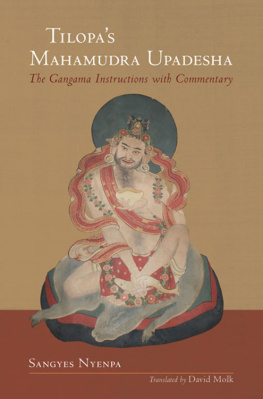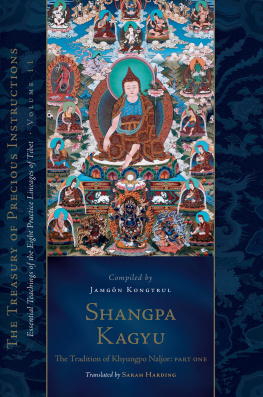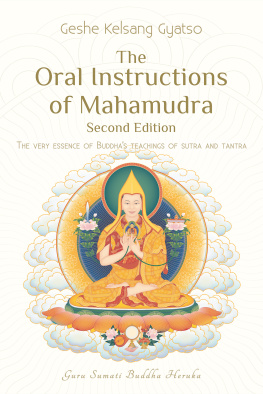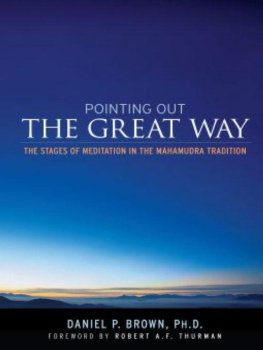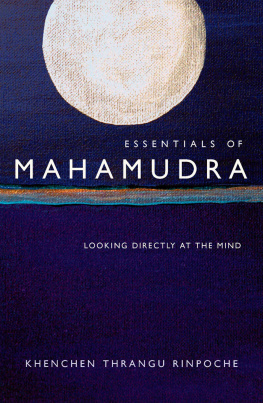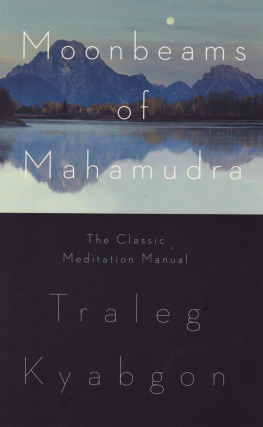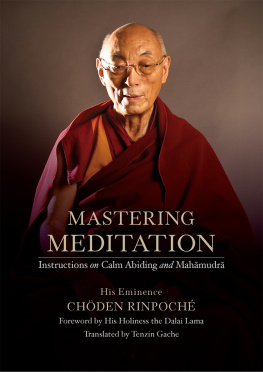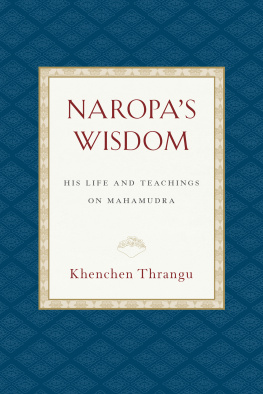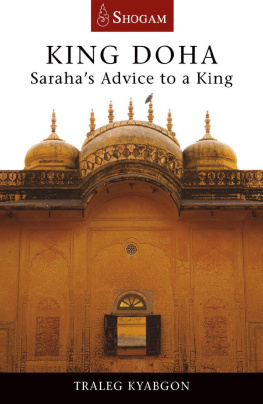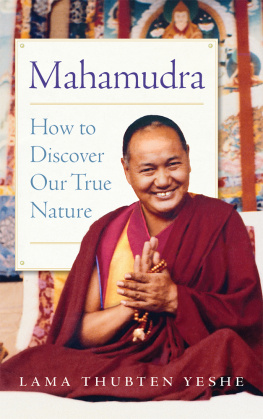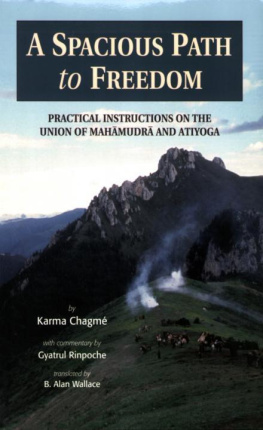ABOUT THE BOOK
All lineages of Mahamudra meditation have their source in a verse teachinga song of realizationsung by the Mahasiddha Tilopa to his disciple Naropa on the banks of the Ganges River more than a thousand years ago. Since that time, the meaning of Tilopas instructions has been passed directly from master to disciple in a continuous stream that exists unbroken to this day. This book offers the reader a rare glimpse into the Mahamudra oral transmission, given in a traditional Tibetan context by one of the lineages most learned and accomplished contemporary masters.
Mahamudra meditation, while highly advanced, is yet simple, practical, and accessible for anyone, because what is identified and meditated upon is the very nature of ones own mind. In Sangyes Nyenpa Rinpoches words, The distinction between deception and liberation lies in whether we understand the ever-present nature of our own mind or not. Knowing our own face is liberation; not knowing our own face is samsara. This is not something far distant from us.
The instructions are ideal for Westerners because the root text is manageable and Rinpoche has provided an outline of his own composition that makes it easily understandable. He explains terminology with frequent comparisons between Dzogchen and Mahamudra, quotes prolifically from scripture, gives clear examples, and generally cajoles, admonishes, and encourages his listeners to be true to their own spiritual path.
The Tenth SANGYES NYENPA Rinpoche was born into a family of practitioners at the temple of Paro Taktsang in Bhutan. Recognized by His Holiness the Sixteenth Karmapa and educated at Rumtek, Sikkim, Sangyes Nyenpa Rinpoche is one of the Kagyu lineages most accomplished and respected tulkus. He is based in Kathmandu, Nepal, and teaches worldwide.
Sign up to receive inspirational Tibetan Dharma teachings and special offers from Shambhala Publications.

Or visit us online to sign up at shambhala.com/edharmaquotes.
Tilopas Mahamudra Upadesha

The Gangama Instructions with Commentary
Sangyes Nyenpa
TRANSLATED BY
David Molk
S NOW L ION
B OSTON & L ONDON
2014
Snow Lion
An imprint of Shambhala Publications, Inc.
Horticultural Hall
300 Massachusetts Avenue
Boston, Massachusetts 02115
www.shambhala.com
2014 by Sangyes Nyenpa
Cover art: Mural painting (17th century) of Tilopa in the Old Dukhang (Assembly Hall) of the Monastery of Hemis, Ladakh. Photograph by Chiara Bellini.
Author photo 2013 Werner Bauer, DGPh
All rights reserved. No part of this book may be reproduced in any form or by any means, electronic or mechanical, including photocopying, recording, or by any information storage and retrieval system, without permission in writing from the publisher.
Library of Congress Cataloging-in-Publication Data
Sas-rgyas-man-pa X, Rin-po-che, 1964
[Phyag chen gangamai grel pa dam pai al gyi man ag. English]
Tilopas Mahamudra Upadesha: the Gangama instructions with commentary / Sangyes Nyenpa; translated by David Molk.First edition.
pages cm
The oral instruction of Sangyes Nyenpa Rinpoche given to the monks and nuns of Benchen Monastery, Pharping, Kathmandu, Nepal in 2001.
Includes bibliographical references.
eISBN 978-0-8348-2974-9
ISBN 978-1-55939-426-0 (pbk.: alk. paper)
1.MeditationTantric Buddhism. 2. Tillopda, 9881069. Phyag rgya chen poi man ag. I. Molk, David, 1953 translator. II. Title.
BQ8939.5.S2613 2014
294.34435dc23
2013028406
C ONTENTS

May this publication of the teaching of the Gangama Mahamudra, given and transcribed by Sangyes Nyenpa Rinpoche at Yanglesh Benchen Drubkang, open wide the doors of pure virtue and goodness.
Karmapa Ogyen Trinley
6 May 2008

T HIS Discovery of Sacred Secrets on the Banks of the Ganges: A Commentary to Tilopas Gangama Mahamudra Instructions is intended primarily for great meditators. Since there is so much to learn and we dont know how long we may live, it would be a shame if those who are doing essence-practice for the sake of ultimate aims could not learn the tantric dohas, the spiritual songs of realization that escaped the lips of the supreme mahasiddhas of India. I would regret, however, if such precious instructions were shown to any who would misuse them for worldly aims. Therefore, I ask those of highest faculties who rely on discerning insight to practice it without mistaking what is beneficial for this and future lives. An important point to note is that I would ask uninitiated readers to temporarily not read How to Dispel Obstacles, from the middle of verse nineteen onward, as this deals only with tantric techniques. First train in the preliminaries. Then, in conjunction with receiving the oral instructions from the guru, in accordance with how one studies, vast benefit is certain to emerge.
Nyenpa

T HIS COMMENTARY to the Ganges Mahamudra is the oral instruction of Sangyes Nyenpa Rinpoche given to the monks and nuns of Benchen Monastery, Pharping, Kathmandu, Nepal in 2001. The root text was given as a doha, a spontaneous song expressing spiritual realization, by the mahasiddha Tilopa and so onall of the illustrious masters of the Kagyu, the Lineage of Transmissionthat we are fortunate to have these instructions and the transmission of sudden enlightenment that accompanies them intact and fully potent to the present day.
These instructions present, in an essential and condensed form, the ultimate path and result of Buddhist meditation: realization of the ultimate nature of oneself and all phenomena. Rather than analyzing self and other phenomena individually, however, the Mahamudra approach derives understanding of the ultimate nature of phenomena by considering their relationship to mind, in particular the very subtle mind of clear light. Mahamudra, great seal, refers to this ultimate nature that can be experienced and realized through meditation. Not a simple negation, it is a primordial union of luminous awareness and emptiness that is identified in the Ornament of Stainless Light commentary to the Kalachakra tantra:
The primordial mind is a very subtle mind, and when manifest, it takes as its objects phenomena such as the complete absence of any limiting conceptual elaboration, the direct cognition of emptiness. It has the ability to create every quality of a buddha, and it has dwelt in the continuum of every sentient being since beginningless time without interruption. When it is purified it becomes the dharmakaya.
When Buddha said that all living beings have buddha nature he was referring to this luminous core of consciousness that becomes a buddha. It is a pure, completely nonconceptual blissful awareness that underlies and is the source of all consciousness yet is empty of all grosser levels of awareness. Referred to as sem-nyi in Tibetan, often translated as mind-itself, I have coined the term elemental mind to attempt to describe this irreducible, unpolluted element of consciousness.
Mahamudra meditation is an eminently practical approach to Buddhadharma because it focuses attention directly on our buddha nature as the main path to manifesting it; the mind itself is taken as the path. Without using many technical terms that could possibly obscure it further, clear light mind, empty of all grosser levels of awareness, is caused to manifest by focusing directly on the essence of the present moment of awareness. By not fueling thoughts of past or future, grosser levels of awareness such as strong delusions of attachment and aversion are disempowered and allowed to subside. If it can be accessed directly, no other practice is necessary, and it is considered to be a separate tantra that did not require initiation. If that is not possible, however, generation and completion stage tantric practice of deity yoga is necessary, for which tantric initiation is required.
Next page
